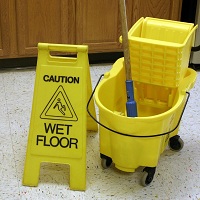Building Operations and Maintenance Services
Follow these sustainable strategies once your renovation and construction projects are complete to help ensure that the building and interior spaces are operated in an environmentally sustainable manner. Operations staff should endeavor to establish and implement best practices in energy efficiency, resource conservation, environmentally preferable products, and other sustainable practices. Federal projects should meet or exceed the Guiding Principles for Sustainable Federal Buildings. Refer to the Apply Section of SFTool for representative project case studies to discover key practices, benefits, results, and checklists. See the Green Procurement Compilation for specific information on sustainable services.
For sustainable strategies specific to non-office workspaces, such as cafeterias and labs, refer to the Explore Section.
Sustainability In Action
Education is the key to changing behavior.
Provide information and training regarding key sustainable strategies of the building and interior spaces and how occupants and operations staff can support the following sustainable efforts:
- Occupant health and wellness (indoor environmental quality)
- Resource conservation (water, energy, materials)
- Waste reduction (recycling)
- Responsible procurement (ecologically sensitive materials/vendors)
- Transportation (mass transit and alternative commuting)
Operations Best Practices
- Establish a green team to promote sustainable practices
- Leverage operational expertise, as well as the scale and diversity of buildings, across building portfolios
- Test promising sustainable technologies in real-life circumstances and implement innovative products, services, and ideas that offer the best value
- Respond quickly to occupants' comfort concerns to help with occupant satisfaction
- Evaluate the impact of operations policies and practices on energy performance
- Provide feedback to occupants on resource use (energy, water, materials) to help achieve sustainability goals
Procurement Best Practices
Indoor Environmental Quality
- Ensure operations staff is conducting preventive maintenance on all building exhaust systems (restrooms, garage exhaust fans, etc).
- Maximize access to daylight and views while avoiding the negative effects of glare
- Ensure occupant comfort
- Enable occupant control of ambient conditions in workspaces through individual or zone control of ventilation and temperature
Energy Performance
Water Management
- Submeter of water systems to identify future opportunities for improvement
- Educate occupants about water efficient fixtures and water saving strategies
- Train to operations staff on proper maintenance of waterless urinals
Waste Reduction and Management
- Communicate facilities guidelines and announcements electronically, versus using printed materials
- Confirm the availability and operational details of recycling and composting infrastructure and institute a program to recycle materials
- Host recycling and composting workshops to educate occupants about what can be recycled and composted and how materials are collected
- Provide well labeled and easily accessible containers for the collection and storage of recyclable and compostable materials; make recycling and composting the default option
- Divert construction waste from landfills and facilitate the recycling of construction waste through the standardization of processes
Custodial Services
- Ensure that a Healthy Cleaning Plan, based on a list of healthy cleaning needs, including areas to be cleaned and levels of service, is being implemented, as well as monitored and audited for quality assurance
- Ensure that an Exposure Control Plan is being implemented
- Use cleaners certified to a sustainability standard or ecolabel (e.g., BioPreferred or Safer Choice)
- Follow GSA's Integrated Pest Management Guidance and use the Green Procurement Compilation (GPC) for guidance on procuring IPM services
- Ensure that a Hazard Communication Plan and Pandemic Plan have been developed
References/Resources
- Acquisition.gov | Federal Acquisition Regulation (FAR) Part 23 - Environment, Energy, and Water Efficiency, Renewable Energy Technologies, Occupational Safety, and Drug-Free Workplace

- Acquisition.gov | Federal Acquisition Regulation (FAR) Part 52 - Solicitation Provisions and Contract Clauses, Subpart 223

- LEED Building Operations & Maintenance (O+M) Rating System
 and LEED Reference Guide for Building Operations and Maintenance
and LEED Reference Guide for Building Operations and Maintenance


